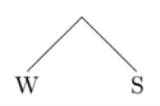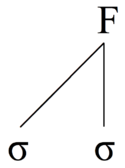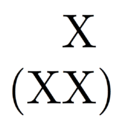
Iamb
Encyclopedia
An iamb (ˈaɪæm or iambus) is a metrical foot used in various types of poetry
. Originally the term referred to one of the feet of the quantitative meter of classical Greek prosody: a short syllable followed by a long syllable (as in delay). This terminology was adopted in the description of accentual-syllabic verse
in English, where it refers to a foot comprising an unstressed syllable followed by a stressed syllable (as in a-bove).
, a Greek minor goddess of verse, especially scurrilous, ribald humour. In ancient Greece iambus
was mainly satirical poetry, lampoons, which did not automatically imply a particular metrical type. Iambic metre took its name from being characteristic of iambi, not vice versa.


 In accentual-syllabic verse
In accentual-syllabic verse
an iamb as a foot that has the rhythmic pattern:
Using the 'ictus and x' notation (see systems of scansion
for a full discussion of various notations) we can write this as:
The word 'attempt' is a natural iamb:
In phonology
, an iambic foot is notated in a flat representation as (σ'σ) or as foot tree with two branches W and S where W = weak and S = strong.
Iambic pentameter
is one of the most commonly used measures in English
and German
poetry
. A line of iambic pentameter comprises five consecutive iambs.
Iambic trimeter
is the metre of the spoken verses in Greek tragedy and comedy, comprising six iambs - as one iambic metrum consisted of two iambs. In English accentual-syllabic verse, iambic trimeter is a line comprising three iambs.
Another common iambic form is ballad verse, in which a line of iambic tetrameter
is succeeded by a line of iambic trimeter, usually in quatrain
form.
A. B. "Banjo" Paterson
wrote much of his poetry in iambic heptameter
(which is sometimes called the 'fourteener'), and Samuel Taylor Coleridge
's The Rime of the Ancient Mariner
also conforms to this stress pattern (although it is usually written as though it were composed of lines alternating between iambic tetrameter
and iambic trimeter).
The reverse of an iamb is called a trochee
.
(Although, it could be argued that this line in fact reads: Shall I compare thee to a summer's day?
Meter is often broken in this way, sometimes for intended effect and sometimes simply due to the sound of the words in the line. Where the stresses lie can be debated, as it depends greatly on where the reader decides to place the stresses. Although in this meter the foot ceases to be iambs but trochee
s.)
Key:
Poetry
Poetry is a form of literary art in which language is used for its aesthetic and evocative qualities in addition to, or in lieu of, its apparent meaning...
. Originally the term referred to one of the feet of the quantitative meter of classical Greek prosody: a short syllable followed by a long syllable (as in delay). This terminology was adopted in the description of accentual-syllabic verse
Accentual-syllabic verse
Accentual-syllabic verse is an extension of accentual verse which fixes both the number of stresses and syllables within a line or stanza. Accentual-syllabic verse is highly regular and therefore easily scannable...
in English, where it refers to a foot comprising an unstressed syllable followed by a stressed syllable (as in a-bove).
Etymology
The word iamb comes from IambeIambe
Iambe in Greek mythology was a Thracian woman, daughter of Pan and Echo and a servant of Metaneira, the wife of Hippothoon. Others call her a slave of Celeus,king of Eleusis...
, a Greek minor goddess of verse, especially scurrilous, ribald humour. In ancient Greece iambus
Iambus (genre)
Iambus was a genre of ancient Greek poetry that included but was not restricted to the iambic meter and whose origins modern scholars have traced to the cults of Demeter and Dionysus. The genre featured insulting and obscene language...
was mainly satirical poetry, lampoons, which did not automatically imply a particular metrical type. Iambic metre took its name from being characteristic of iambi, not vice versa.
Accentual-syllabic use



Accentual-syllabic verse
Accentual-syllabic verse is an extension of accentual verse which fixes both the number of stresses and syllables within a line or stanza. Accentual-syllabic verse is highly regular and therefore easily scannable...
an iamb as a foot that has the rhythmic pattern:
| da | DUM |
Using the 'ictus and x' notation (see systems of scansion
Systems of scansion
A system of scansion is a way to mark the metrical patterns of a line of poetry. In classical poetry, these patterns are based on the different lengths of each syllable, and in English poetry, they are based on the different levels of stress placed on each syllable. In both cases, the meter often...
for a full discussion of various notations) we can write this as:
| |
|
The word 'attempt' is a natural iamb:
| |
|
| at- | tempt |
In phonology
Phonology
Phonology is, broadly speaking, the subdiscipline of linguistics concerned with the sounds of language. That is, it is the systematic use of sound to encode meaning in any spoken human language, or the field of linguistics studying this use...
, an iambic foot is notated in a flat representation as (σ'σ) or as foot tree with two branches W and S where W = weak and S = strong.
Iambic pentameter
Iambic pentameter
Iambic pentameter is a commonly used metrical line in traditional verse and verse drama. The term describes the particular rhythm that the words establish in that line. That rhythm is measured in small groups of syllables; these small groups of syllables are called "feet"...
is one of the most commonly used measures in English
English language
English is a West Germanic language that arose in the Anglo-Saxon kingdoms of England and spread into what was to become south-east Scotland under the influence of the Anglian medieval kingdom of Northumbria...
and German
German language
German is a West Germanic language, related to and classified alongside English and Dutch. With an estimated 90 – 98 million native speakers, German is one of the world's major languages and is the most widely-spoken first language in the European Union....
poetry
Poetry
Poetry is a form of literary art in which language is used for its aesthetic and evocative qualities in addition to, or in lieu of, its apparent meaning...
. A line of iambic pentameter comprises five consecutive iambs.
Iambic trimeter
Iambic trimeter
iambic trimeter is a meter of poetry consisting of three iambic units per line.In ancient Greek poetry, iambic trimeter is a quantitative meter, in which a line consisted of three iambic metra and each metron consisted of two iambi...
is the metre of the spoken verses in Greek tragedy and comedy, comprising six iambs - as one iambic metrum consisted of two iambs. In English accentual-syllabic verse, iambic trimeter is a line comprising three iambs.
Another common iambic form is ballad verse, in which a line of iambic tetrameter
Tetrameter
Tetrameter: [ti'tramitə]; te·tram·e·ter; a verse of four measuresOrigin: early 17th century : from late Latin tetrametrus, originally neuter from Greek tetrametros 'having four measures,' from tetra- 'four' + metron 'measure'....
is succeeded by a line of iambic trimeter, usually in quatrain
Quatrain
A quatrain is a stanza, or a complete poem, consisting of four lines of verse. Existing in various forms, the quatrain appears in poems from the poetic traditions of various ancient civilizations including Ancient Greece, Ancient Rome, and China; and, continues into the 21st century, where it is...
form.
A. B. "Banjo" Paterson
Banjo Paterson
Andrew Barton "Banjo" Paterson, OBE was an Australian bush poet, journalist and author. He wrote many ballads and poems about Australian life, focusing particularly on the rural and outback areas, including the district around Binalong, New South Wales where he spent much of his childhood...
wrote much of his poetry in iambic heptameter
Heptameter
Heptameter is one or more lines of verse containing seven metrical feet .An example from Lord Byron's Youth and Age:...
(which is sometimes called the 'fourteener'), and Samuel Taylor Coleridge
Samuel Taylor Coleridge
Samuel Taylor Coleridge was an English poet, Romantic, literary critic and philosopher who, with his friend William Wordsworth, was a founder of the Romantic Movement in England and a member of the Lake Poets. He is probably best known for his poems The Rime of the Ancient Mariner and Kubla...
's The Rime of the Ancient Mariner
The Rime of the Ancient Mariner
The Rime of the Ancient Mariner is the longest major poem by the English poet Samuel Taylor Coleridge, written in 1797–98 and was published in 1798 in the first edition of Lyrical Ballads. Modern editions use a later revised version printed in 1817 that featured a gloss...
also conforms to this stress pattern (although it is usually written as though it were composed of lines alternating between iambic tetrameter
Tetrameter
Tetrameter: [ti'tramitə]; te·tram·e·ter; a verse of four measuresOrigin: early 17th century : from late Latin tetrametrus, originally neuter from Greek tetrametros 'having four measures,' from tetra- 'four' + metron 'measure'....
and iambic trimeter).
The reverse of an iamb is called a trochee
Trochee
A trochee or choree, choreus, is a metrical foot used in formal poetry consisting of a stressed syllable followed by an unstressed one...
.
Tetrameter
Iambic tetrameter is a meter referring to a line consisting of four iambic feet:- Lo, thus I triumph like a king,
- Content with that my mind doth bring. (Edward DyerEdward DyerSir Edward Dyer was an English courtier and poet.-Life:The son of Sir Thomas Dyer, Kt., he was born at Sharpham Park, Glastonbury, Somerset. He was educated, according to Anthony Wood, either at Balliol College, Oxford or at Broadgates Hall , and left after taking a degree...
, "My Mind to Me A Kingdom Is")
- 'Twas brillig, and the slithy toves
- Did gyre and gimble in the wabe. (Lewis CarrollLewis CarrollCharles Lutwidge Dodgson , better known by the pseudonym Lewis Carroll , was an English author, mathematician, logician, Anglican deacon and photographer. His most famous writings are Alice's Adventures in Wonderland and its sequel Through the Looking-Glass, as well as the poems "The Hunting of the...
, "JabberwockyJabberwocky"Jabberwocky" is a nonsense verse poem written by Lewis Carroll in his 1872 novel Through the Looking-Glass, and What Alice Found There, a sequel to Alice's Adventures in Wonderland...
")
Pentameter
Iambic Pentameter is a meter referring to a line consisting of five iambic feet:- To strive, to seek, to find, and not to yield. (Alfred Tennyson, "UlyssesUlysses (poem)"Ulysses" is a poem in blank verse by the Victorian poet Alfred, Lord Tennyson , written in 1833 and published in 1842 in Tennyson's well-received second volume of poetry. An oft-quoted poem, it is popularly used to illustrate the dramatic monologue form...
")
- Shall I compare thee to a summer's day? (William ShakespeareWilliam ShakespeareWilliam Shakespeare was an English poet and playwright, widely regarded as the greatest writer in the English language and the world's pre-eminent dramatist. He is often called England's national poet and the "Bard of Avon"...
, Sonnet 18Sonnet 18Sonnet 18, often alternately titled Shall I compare thee to a summer's day?, is one of the best-known of 154 sonnets written by the English playwright and poet William Shakespeare...
)
(Although, it could be argued that this line in fact reads: Shall I compare thee to a summer's day?
Meter is often broken in this way, sometimes for intended effect and sometimes simply due to the sound of the words in the line. Where the stresses lie can be debated, as it depends greatly on where the reader decides to place the stresses. Although in this meter the foot ceases to be iambs but trochee
Trochee
A trochee or choree, choreus, is a metrical foot used in formal poetry consisting of a stressed syllable followed by an unstressed one...
s.)
- A horse! A horse! My kingdom for a horse! (William ShakespeareWilliam ShakespeareWilliam Shakespeare was an English poet and playwright, widely regarded as the greatest writer in the English language and the world's pre-eminent dramatist. He is often called England's national poet and the "Bard of Avon"...
, Richard IIIRichard III (play)Richard III is a history play by William Shakespeare, believed to have been written in approximately 1591. It depicts the Machiavellian rise to power and subsequent short reign of Richard III of England. The play is grouped among the histories in the First Folio and is most often classified...
)
Heptameter
Iambic Heptameter is a meter referring to a line consisting of seven iambic feet:- I s'pose the flats is pretty green up there in Ironbark. (A. B. Paterson, The Man from IronbarkThe Man from Ironbark"The Man From Ironbark" is a famous poem by Australian bush poet Banjo Paterson.It was first published in The Bulletin on 17 December 1892. The poem relates the experiences of a naïve man from the Bush, who reacts badly to a practical joke sprung on him by a mischievous barber in Sydney...
)
Key:
- Non-bold = unstressed syllable
- Bold = stressed syllable

